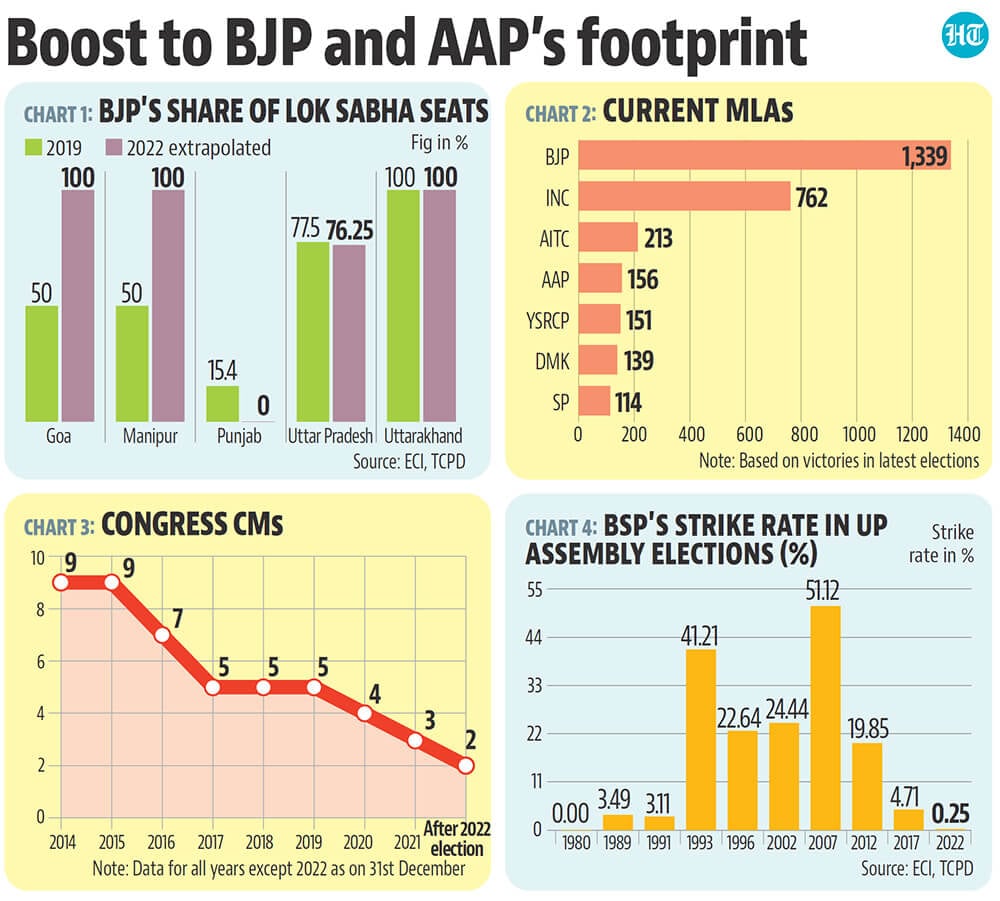The story in numbers: What’s the larger takeaway of the poll verdict
The BJP went to this election cycle as the incumbent in four out of five states, and faced double anti-incumbency: it was in power in the states of Uttar Pradesh, Uttarakhand, Manipur and Goa as well as the centre.
New Delhi: The Bharatiya Janata Party (BJP) has achieved convincing victories in Uttar Pradesh, Uttarakhand and Manipur, and looks set to form the government in Goa according to the results announced on March 10. The Aam Aadmi Party (AAP) has achieved a landslide victory in the state of Punjab. What is the larger takeaway from these results? Here are four charts that explain this.

The BJP’s dominance in national politics has received a further boost
The BJP went to this election cycle as the incumbent in four out of five states, and faced double anti-incumbency: it was in power in the states of Uttar Pradesh, Uttarakhand, Manipur and Goa as well as the centre. The last couple of years have not been easy for the country and the economy given the devastating impact of the second wave of the Covid-19 pandemic, an unprecedented contraction of 6.6% in India’s GDP in 2020-21, high levels of unemployment and inflation. The election results, especially in the largest state of Uttar Pradesh, where the BJP was also on a defensive because of the protests against three farm laws, which the government repealed in November 2021, suggest that none of these things mattered in the end. The BJP has managed to increase its vote share by 1.4 percentage points compared to the 2017 assembly elections. Even in Uttarakhand, where the BJP had to change two chief ministers, it has managed to attain a comfortable majority. An extrapolation of the latest assembly results at the Lok Sabha level shows that the BJP is still close to its 2019 tally in these elections. This is bound to create a comfortable narrative for the BJP in coming state elections as well as the 2024 Lok Sabha one.
AAP goes beyond Delhi, one step away from becoming a national party
With its impressive victory in the Punjab assembly elections, the AAP will now have a second state government in the country. It is only the third political party after the BJP and the Congress to have this distinction currently. Even before this, only the Communist Party of India (Marxist) and the Janata Dal have governed more than one state. To be sure, the AAP is still some distance away from fulfilling the technical criterion for a national party (see https://bit.ly/3Cx2Ggu for details). However, the Punjab results will increase AAP’s influence in national politics. The best metric to look at this question is the AAP’s position among political parties in the country by number of MLAs. With 62 MLAs in Delhi, 92 in Punjab and 2 in Goa, the AAP’s total number of MLAs in the country is the fourth highest after the BJP, Congress and the Trinamool Congress.
The Congress is vulnerable to anti-incumbency but cannot exploit it
The latest election results are unambiguously bad for the Congress. It has suffered a huge defeat in Punjab, the only state where it was in power among the five that went to polls. The anti-incumbency sentiment however, seems to be limited to Punjab. The BJP, which was ruling in the other four states which went to polls has managed to overcome anti-incumbency. It has managed a comfortable majority in Uttar Pradesh, Manipur and Uttarakhand and emerged as the single largest party in Goa. This does not bode well for the Congress in the run-up to 2024 Lok Sabha elections. It will be trying to dislodge the BJP in Gujarat and Himachal Pradesh in elections scheduled for end of this year and then try and defend its governments in Rajasthan and Chhattisgarh in late 2023 even as it tries to win back Madhya Pradesh from the BJP. If the current trends continue, the Congress runs the risk of ending up without any state government of its own before the 2024 elections.
End of the road for Bahujan Samaj Party?
In 1995, Mayawati created history by becoming the first Dalit chief minister of Uttar Pradesh, India’s largest state. Her tryst with power was the result of the political genius of Kanshiram, who founded the Bahujan Samaj Party in 1984. The BSP was always a political force to reckon with in Uttar Pradesh in the post-Babri Masjid demolition phase and its peak came in 2007 when it managed to form a government in the state. The BSP also had 19 and 20 Lok Sabha MPs in 2004 and 2009. Since 2012, when the BSP lost the state elections to the SP, it has been a non-stop downward slide for the what still is India’s largest political party with an Ambedkarite ideology. With its vote share and seat share hitting the lowest ever in Uttar Pradesh in these elections, the BSP faces a clear existential threat. The fact that the BSP will not have even one Dalit MLA in UP (as of 8:.30pm it was leading in only Rasara, a general constituency), also raises serious questions about its support base among its core supporters.






